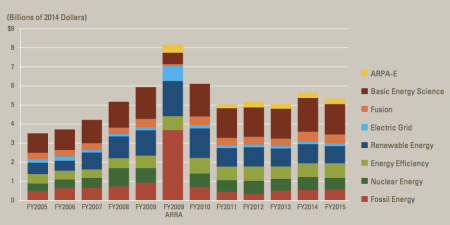
Concerning energy research, the United States is falling behind the pack. Sure, we’re in the middle – quite possibly the latter stages – of an oil and gas renaissance, but the nation’s energy secure future, while paved with hydrocarbons, will increasingly rely on renewables deployment and grid innovation.
According to a new report from the American Energy Innovation Council (AEIC), a committee of six executives including Bill Gates and General Electric CEO Jeffrey Immelt, US funding for energy research development and demonstration (RD&D) is detrimentally modest – stunting current growth and weakening the nation’s competitive advantage. The committee argues that current spending of about $5 billion annually should be tripled immediately. As a percentage of economic output, US funding lags well behind its western counterparts Canada, France, Denmark, and Norway – maybe the shining example of a hydrocarbon-fueled green state – among others.
Green technology innovation is trending east however, and China, Japan, and South Korea are leading the charge – the countries are dominating global patents, leading filings in biofuels, solar thermal, solar PV, and wind. And research is leading to application. In 2013, China and Japan deployed more than half of global solar PV additions. By 2025, China is expected to generate just over a quarter of global renewable power – together, Asia will account for more than 40 percent.
Read more: Can We Fix Climate Change With Technology?
But back to that $5 billion of US funding – where does it go? All over the place, really.

Approximately 10 percent is designated for fossil fuels. Of that roughly $500 million allocation very little actually goes to oil and gas research – only 5 percent, or $25 million. Instead, more than 70 percent is appropriated to coal and carbon sequestration research. The DOE’s clean coal R&D is focused on increasing overall system efficiencies, developing carbon utilization and storage technologies for existing and new facilities, as well as reducing the capital cost of all of the above.
Around $1 billion is set aside for nuclear and fusion energy research. The DOEaims to develop sustainable nuclear fuel cycles and extend the life of nuclear reactors. Unlike nuclear fission, fusion energy is still finding its feet. As a result, the research is directed at advancing the fundamental science to develop a predictable and sustainable fusion energy source.
A sizeable 30 percent of the funding – $1.5 billion – is assigned to energy efficiency and renewable energy in relatively equal shares. $263 million is authorized for vehicle efficiency R&D – roughly 10 times the amount for oil and gas-related research. The primary foci of the DOE’s Vehicle Technologies Office are electric/hybrid drive batteries and hydrogen fuel cell technologies.
Read more: Can Tesla’s Latest Venture Live Up To The Hype?
Looking at renewables, solar R&D receives around $188 million; wind energy receives markedly less at $90 million. Together, their 2015 DOE research allocation is more than 20 percent less than that of clean coal. Not awful, but perhaps misguided – wind and solar generate more jobs per average megawatt as well as more jobs per dollar invested than coal.
Finally, approximately $125 million is allocated for the electric grid. The DOE is working on interactive grid technology and advanced energy storage, vitally necessary tech if renewables are to be meaningfully scaled up.
The AEIC’s own breakdown of spending is relatively similar – $11 billion difference and a dramatic increase in grid funding notwithstanding. Their main quibble – and they’re not wrong – is that the funding format is ill matched to its target industries. Simply put, small annual appropriations are not suitable for the energy industry, where large tranches are necessary over a defined multi-year period. Left unchecked, such funding decisions ultimately leave the US behind the curve.
This article originally appeared on Oilprice.com.
More from Oilprice.com:
More Must-Reads from TIME
- Why Trump’s Message Worked on Latino Men
- What Trump’s Win Could Mean for Housing
- The 100 Must-Read Books of 2024
- Sleep Doctors Share the 1 Tip That’s Changed Their Lives
- Column: Let’s Bring Back Romance
- What It’s Like to Have Long COVID As a Kid
- FX’s Say Nothing Is the Must-Watch Political Thriller of 2024
- Merle Bombardieri Is Helping People Make the Baby Decision
Contact us at letters@time.com